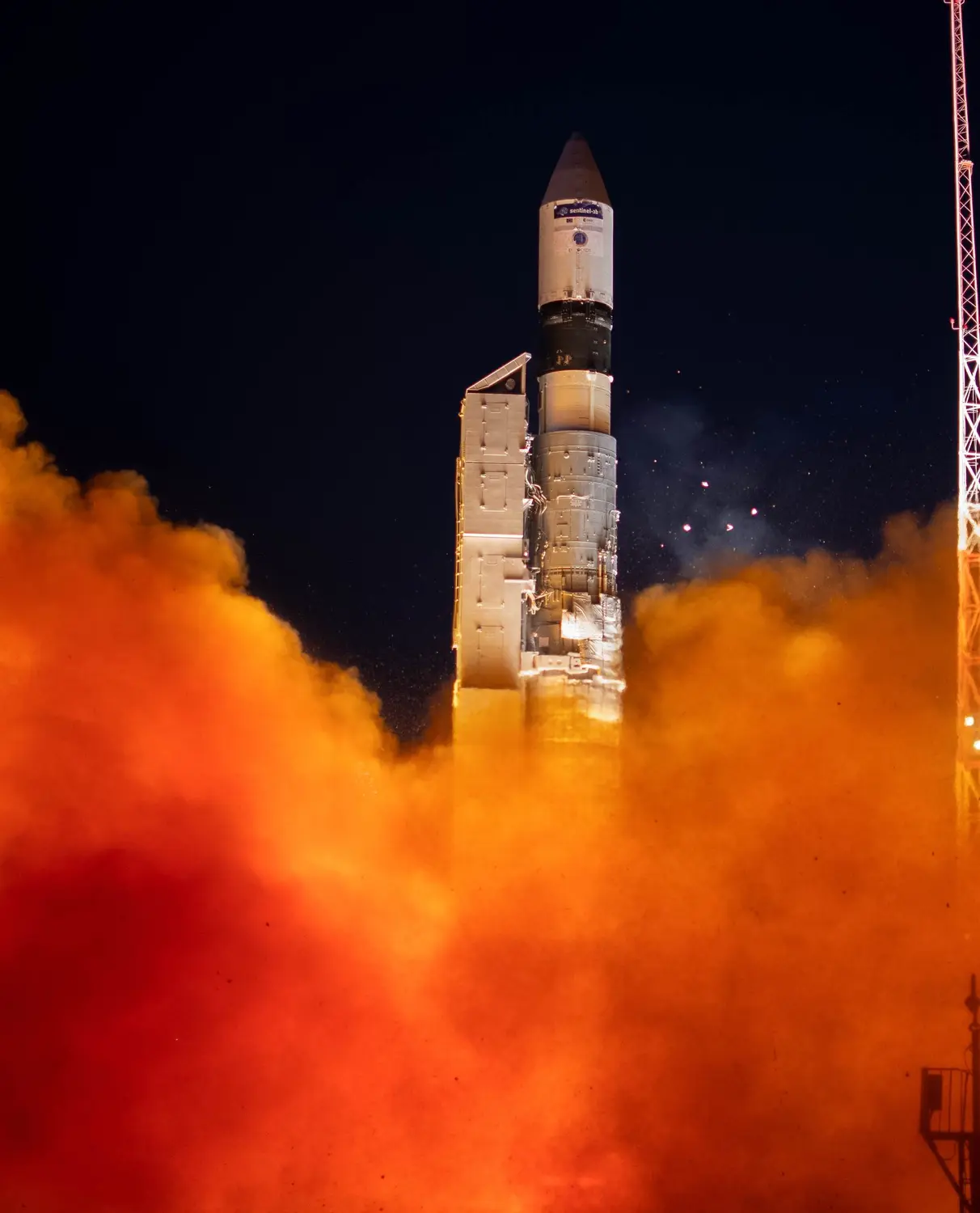Monitor-E GVM & Others
Launch Success
Liftoff Time (GMT)
14:15:25
Monday June 30, 2003
Mission Details
Launch Notes
First CubeSats to be launched into space.
Monitor-E GVM
The mockup of Monitor-E (GVM), the Khrunichev-designed Russian Earth observation satellite, transmitted mission profile simulation data during its entire flight. This mockup remained on the Briz-KM upper stage and will also de-orbit with it. For this final manoeuvre the upper stage was re-ignited once more.
Low Earth Orbit
1 Payload
750 kilograms
MIMOSA
MIMOSA (Micro-Measurements Of Satellite Acceleration) is a microsatellite to measure atmospheric drag. The only scientific payload is an electrostatically compensated, six-degrees-of-freedom accelerometer with cubic proof mass. The accelerometer can detect quasi-steady accelerations of extremely low magnitude of about 10^-11 m/s^2. The accelerometer is mounted at the center of gravity of the MIMOSA satellite.
Low Earth Orbit
1 Payload
66 kilograms
AAU-Cubesat
The main purpose of the AAU-Cubesat (Aalborg University Cubesat) project is for the involved students to achieve a great deal of knowledge about designing and constructing Space worthy technology, but the "scientific" mission of the AAU-CubeSat is to take pictures of the surface of the Earth and particularly of Denmark by using the on-board camera. The images recorded by the satellite were later transmitted to the ground station, located at Aalborg University, from where they were distributed over the Internet and made accessible to the general public.
Low Earth Orbit
1 Payload
1 kilograms
XI 4
The code name of ISSL's CubeSat is "XI" (X-factor Investigator). This derives from its cubic shape (XI means domino in Japanese). The XI mission is on-orbit verifications of the technology necessary for a super-small satellite system. Acquiring indispensable technology on spacecraft, such as communication, power, and electronics, it will establish the development methodology of the small satellite. And by extensively using commercial-off-the-shell components, the total development cost will be drastically reduced and a database on the space use of the COTS parts will be built. A number of Cubesat-XI prototypes have been built - the fourth is the first flight model with the fifth being its backup.
Low Earth Orbit
1 Payload
1 kilograms
CanX-1
The CanX-1 (Canadian Advanced Nanospace eXperiments) PicoSatellite Mission is the first in a series of CubeSat Missions at the University of Toronto. The Canadian Advanced Nanospace eXperiments (CanX) promote the development and testing of low-cost space technologies and push the envelope of performance that can be achieved with small low-power devices.
Low Earth Orbit
1 Payload
1 kilograms
MOST
MOST (Microvariability and Oscillation of Stars) is designed to detect brightness oscillations in stars down to a level of a few parts per million - the amplitude of the Sun's five-minute oscillations seen in integrated light. Those oscillations (caused by turbulent sound waves propagating within the Sun) allow us to probe seismically the otherwise hidden solar interior. The MOST mission resulted in a number of discoveries. In 2004 the MOST team reported that the star Procyon does not oscillate to the extent that had been expected, although this has been disputed. In 2006 observations revealed a previously unknown class of variable stars, the "slowly pulsating B supergiants" (SPBsg). In 2011, MOST detected transits by exoplanet 55 Cancri e of its primary star, based on two weeks of nearly continuous photometric monitoring, confirming an earlier detection of this planet and allowing investigations into the planet's composition.
Low Earth Orbit
1 Payload
53 kilograms
DTUSat 1
DTUSat-1 (Danmarks Tekniske Universitet Satellite) is a picosatellite designed and built by students from the Technical University of Denmark, DTU. The main payload of DTUsat is an electrodynamic tether for dumping the satellite. The tether is deployed using a novel yo-yo system, greatly simplifying construction and deployment. A calibrated test transmitter is flown as a secondary payload. The satellite is 3-axis stabilized using magnetorquers, while attitude determination is done by a combination of a 3-axis magnetometer and 5-chip scale dual-axis sun angle sensors designed and built for this satellite. The mass of each sun angle sensor including supporting electronics is only 3 g. All flight electronics are designed using modern 3.3 V CMOS integrated circuits, lowering total power consumption to about 400 mW while providing about 10 MIPS for application software.
Low Earth Orbit
1 Payload
1 kilograms
QuakeSat 1
A Palo Alto, Calif.-based start-up is privately funding a mission that it hopes will make earthquake forecasts as common as weather forecasts. QuakeFinder, LCC, a spin-off of Stellar Solutions Inc., also of Palo Alto, launched a very small satellite (3U CubeSat) in 2003. Their QuakeSat 1 scanned the globe for dramatic changes in extremely low-frequency electromagnetic (ELF) waves that some scientists believe precede and follow seismic activity. The 3-kilogram QuakeSat, which was being built by Stanford University students as part of its CubeSat program, covered Earth every four days in a near-polar orbit 700-900 kilometers in altitude. QuakeFinder had deployed 25 ground sensors donated to high school students along California faults, but since the mission is global in scale and only designed to last six months to a year, QuakeFinder technicians had to rush to a potential seismic area with ground sensors to confirm the data and gain more precise readings.
Low Earth Orbit
1 Payload
5 kilograms
CUTE 1
The CUTE 1 (Cubical TITech Engineering Satellite) will conduct the following three missions. - Communication Mission - Continuous transmission of CW-Telemetry by CW transmitter (As a beacon) - Transmission of FM-Telemetry including payload data by two different protocols - Ax.25 protocol - SRLL(Simple Radio Link Layer) protocol - Change the two communication protocols by uplink command from ground station - Sensing Mission CUTE-I has various sensors: thermometers, accelerometers, gyros, sun sensor, etc. These sensors measure the temperature, acceleration, and angular velocity of CUTE-I in orbit. - Deployment Mission CUTE-I has a deployable solar cell paddle that can be deployed by a command uplink to verify whether or not the deployment mechanism operates well in the space.
Low Earth Orbit
1 Payload
1 kilograms
Rocket


Manufacturer
KhrunichevPrice
$13.00 million
Rocket
Height: 29.1m
Payload to Orbit
LEO: 2,150 kg
GTO: 0 kg
Liftoff Thrust
1,875 Kilonewtons
Fairing
Diameter: 2.62m
Height: 6.74m
Stages
3
Launch Site
Stats
Rokot
7th
Mission
1st
Mission of 2003
Khrunichev State Research and Production Space Center
4th
Mission
1st
Mission of 2003
2003
31st
Orbital launch attempt